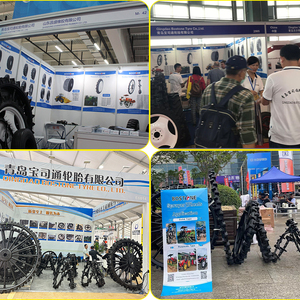(883 products available)









































































































































































Tires 10 x 20 are commonly used for various vehicles, including trucks, buses, and construction equipment. Understanding the different types of 10 x 20 tires can help businesses select the appropriate option for their specific needs. Here are some standard types of 10 x 20 tires:
10-ply tires:
10-ply tires, also known as 10-ply-rated tires, have a load-carrying capacity equivalent to tires with 10 actual plies. They are sturdy and robust, making them appropriate for heavy-duty applications. These tires can handle higher air pressure and have more minor puncture risks. They are commonly used for trucks, trailers, and off-road vehicles. The potential drawback of 10-ply tires is their stiffer ride quality, which may be uncomfortable for some users.
10 x 20 off-road tires:
10 x 20 off-road tires are designed for off-road conditions such as mud, snow, and sand. They have aggressive tread patterns, large tread blocks, and deep voids that provide better traction and self-cleaning capabilities. These tires are ideal for all-terrain vehicles, construction equipment, and agricultural machinery that require reliable performance in off-road environments. Because of their aggressive tread patterns and distinctive designs, off-road tires may generate more noise and have lower on-road handling.
10 x 20 super single tires:
10 x 20 super single tires, also known as wide-base single tires, are large, wide tires frequently utilized in commercial trucking and heavy-duty applications. Each wheel has a single, broad tire, as opposed to dual tires mounted side by side. Super single tires decrease rolling resistance and weight, which can increase fuel efficiency and reduce vehicle weight. They provide better traction and increased load-carrying capacity, making them suitable for long-haul trucking and off-road use. However, super-single tires may be more expensive and require more careful wheel and suspension system maintenance.
10 x 20 all-terrain tires:
10 x 20 all-terrain tires are designed for on-road and off-road performance. They strike a balance between the two, offering reasonable tread patterns that provide adequate traction on various surfaces. These tires are suitable for SUVs and trucks used in multiple environments, including highways and off-road trails. All-terrain tires may need to be more optimized for specific conditions, such as maximizing efficiency in extreme off-road situations or achieving the quietness of dedicated highway tires.
When getting new 10 x 20 truck tires, business buyers should check the specifications to ensure the tires meet their needs. The specifications will help them understand how the tires will perform. Generally, the size is the most important specification for most buyers.
A 10 x 20 tire has a 10-inch width, and the measurement is in millimeters. The aspect ratio indicates that the sidewall height is 20% of the tire's width. The 10 x 20 tires have a rounded sidewall, which makes the tires last longer and improves their performance on rough terrain. These tires have a large contact patch, which means they can support more weight and offer better traction. Because of the increased traction, controlling the vehicle is easier. The tires will be perfect for off-road and all-terrain applications.
10 x 20 tires are radial tires, meaning they have steel belts under the tread. The belts make the tires stronger and improve their performance on highways. The tires won't wear out quickly, and the vehicle will have better handling. The tires are suitable for commercial and on-road applications.
Proper maintenance of 10 x 20 truck tires is crucial for longevity and optimal performance. First, check the air pressure regularly. Proper inflation improves fuel efficiency, maximizes the contact patch, and reduces wear. Stick to the manufacturer's recommended pressure. Check the 10 x 20 tire size for uneven wear and cracks. Uneven wear can show problems with alignment, suspension, or weight distribution. The problem should be fixed. Inspect the tires for any damage, such as stones stuck in the tread. Remove the stones and repair the damage.
Ensure the tread depth is above the legal limit. Worn tires reduce traction and increase the risk of hydroplaning. To increase traction and improve handling, replace the tires when they are worn out. To improve safety, rotate the tires every 5,000 to 7,000 miles. Follow the rotation pattern in the owner's manual.
10 x 20 tires have a large contact patch, which means they can support more weight. Because of the increased traction, controlling the vehicle is easier. The tires will be perfect for off-road and all-terrain applications.
Choosing the right 10 x 20 tires for any particular application or usage involves understanding specific requirements and evaluating options based on those needs. Here are some factors that should be considered when choosing 10 x 20 truck tires:
Replacing 10x20 tires can be a simple DIY task. Here is a step-by-step guide on how to replace the tires:
Q: What are 10x20 tires used for?
A: The tires are standard sizes for trailers and used for specialized equipment. They provide stability and support.
Q: Can 10x20 tires be converted to another tire size?
A: Yes, with the help of a professional tire expert. They can use conversion charts to determine equivalent sizes.
Q: How long do 10x20 tires last?
A: The tires have a long lifespan of up to 6 years. However, the longevity of the tires will depend on various factors such as driving habits, road conditions, and proper maintenance.